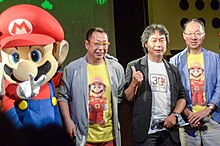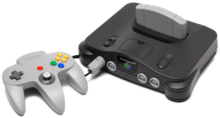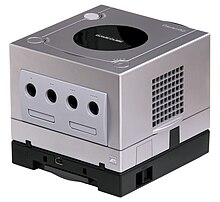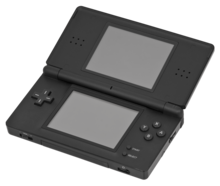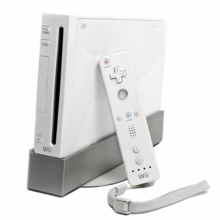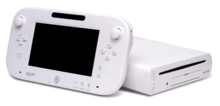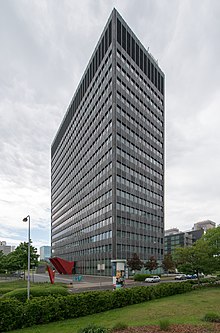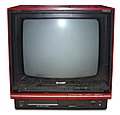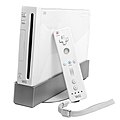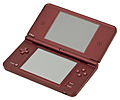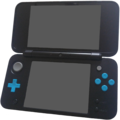Nintendo
| Nintendo Co., Ltd.
|
|
|---|---|
| legal form | Kabushiki-gaisha (joint stock company) |
| ISIN | JP3756600007 |
| founding | September 23, 1889 |
| Seat |
Kyoto , Japan |
| management | Shuntaro Furukawa |
| Number of employees | 6113 (2019) |
| sales | approx. 1.2 trillion yen (9.893 billion euros) (2018/19) |
| Branch | Video game and console development |
| Website | www.nintendo.de |
| As of September 30, 2019 | |
Nintendo KK ( Japanese 任天堂 株式会社 , Nintendō kabushiki-gaisha , English Nintendo Co., Ltd. ) is a Japanese manufacturer of video games and game consoles . Nintendo was originally founded as a manufacturer of playing cards in 1889 by Fusajirō Yamauchi in Kyoto , where the company is still based today. From 1949 to 2002, Hiroshi Yamauchi , the great-grandson of the company founder, headed the company for 53 years. After Yamauchi's resignation, Satoru Iwata took the lead until his death on July 11, 2015. On September 16, 2015, the previous hiring manager Tatsumi Kimishima took over the office of Nintendo President. Kimishima left the company on June 28, 2018 and was replaced by Shuntarō Furukawa .
Nintendo is world-famous for its handheld consoles such as the Game Boy or the Nintendo DS , its stationary game consoles such as the Nintendo Entertainment System (NES for short) or the Wii, as well as numerous long-lasting game series, including Super Mario , Donkey Kong , The Legend of Zelda and Pokémon .
Nintendo's main competitors are Sony's and Microsoft's video game brands PlayStation and Xbox, respectively .
Surname
The name “Nintendo” consists of the three characters 任 nin for “duty, task, responsibility”; 天 ten for “heaven” and 堂 dō for “temple, hall”. Nintendo itself translates the name as "Put happiness in the hands of heaven".
history
1889-1970


On September 23, 1889, Nintendo was founded by Fusajirō Yamauchi. At first, the company only produced the traditional Japanese Hanafuda playing cards. Nintendo quickly became the market leader in Japan in this segment.
Fusajirō Yamauchi retired in 1929 and left Nintendo to his son-in-law Sekiryō Yamauchi, who was originally called Sekiryō Kaneda, but adopted the name Yamauchi at the request of Fusajirō. He renamed the company in Yamauchi Nintendō ( 合 名 会 社 山 内 任天堂 , Gōmei-gaisha ~ , "Yamauchi-Nintendō OHG "). To enable the sale of Hanafuda cards abroad, Sekiryō Yamauchi founded a new company in 1947, KK Marufuku ( 株式会社 丸 福 , "Marufuku AG ") - from 1949 KK Marufuku Karuta Hanbai ( 株式会社 丸 福 か る た 販 売 , “Card game sales Marufuku AG”) and from 1950 Nintendō Karuta KK ( 任天堂 か る た 株式会社 , “Nintendō-Spielkarten AG”). 1951 the card production of Yamauchi Nintendō was merged with the distribution of Nintendō Karuta to the company Nintendō Koppai KK ( 任天堂 骨牌 株式会社 , English Nintendo Playing Card Co., Ltd. ).
Due to declining sales and the bad image of the Hanafuda cards, Nintendo reoriented itself under Yamauchi. A contract was negotiated with Disney for the marketing of playing cards with Disney motifs. In order to build up further branches of the company, Nintendo also experimented with instant rice and the establishment of a taxi company , but finally returned to its core business. 1963 named Hiroshi Yamauchi the company in Nintendō KK ( 任天堂 株式会社 , English Nintendo Co., Ltd. ).
After Gunpei Yokoi's entry in 1969, Nintendo began making other toys in addition to cards. This included the well-known ultra hand , but also love test machines. Nintendo sold around 1.2 million copies of the former toy. Over time, Nintendo produced other toys with varying degrees of success.
1970-1983
In the early 1970s, Nintendo turned its attention to the emerging video game market. In addition to the production of arcade games, Nintendo also tried early on with television-based copies of American game consoles that managed without interchangeable modules.
The first consoles from Nintendo were launched exclusively in Japan in June 1977 under the names Color TV Game 6 and Color TV Game 15 . Five more consoles followed, the racing game Color TV 112 , the color TV game Block Kuzushi , the very unknown variant Color TV game Stuck Monushi and the computer and TV game . Since it was too expensive for Nintendo to manufacture its own microprocessors, it bought them from Mitsubishi . These consoles were a small success and made the company better known in this market segment.
In 1980, the Nintendo Game & Watches developed by Gunpei Yokoi were released. The small electronic play equipment, which could also be stored in small pockets, became a great success worldwide. Today, certain versions of the Game & Watches are sold among collectors at prices of $ 500 or more. 1981 appeared with the arcade game Donkey Kong, the first game of the now world-famous game designer Shigeru Miyamoto .
Encouraged by this success, Hiroshi Yamauchi began with his daughter and son-in-law Minoru Arakawa an expansion in the USA with the aim of establishing a subsidiary there. Nintendo of America was finally founded in 1982. The headquarters was set up in Redmond near Seattle .
In 1983 Nintendo built another branch and founded a subsidiary in Vancouver , Canada . In the same year Nintendo of America was able to increase sales to 10 million US dollars. In July 1983, Nintendo went public in Tokyo .
1983-1989
In 1983, Nintendo brought out the Nintendo Family Computer (Famicom for short) in Japan , which was also marketed in America and Europe from 1985 under the name Nintendo Entertainment System (NES for short). Yamauchi had this idea after the success of the American game console VCS 2600 from Atari . His goal was to offer a console based on the American principle, but at a reasonable price, which should never be boring thanks to interchangeable modules.
Together with the NES, the cornerstone for sustained successful game series was laid; Metroid , Super Mario Bros. and The Legend of Zelda made their debuts on the NES and sold millions of copies. The console was also a great success, causing bottlenecks in processors.
1989-1995
Thanks to a development by Gunpei Yokoi , Nintendo had its greatest success to date: In 1989 the Game Boy appeared together with the game Tetris . Due to its handiness, the excellent battery life and a large selection of high quality games, the Game Boy became the epitome of the handheld console and is still used today as a synonym for mobile gaming devices. Competing products such as the Sega Game Gear or the Atari Lynx were technically better equipped, but significantly more expensive and could not endanger Nintendo's dominance in the mobile video game market.
With the release of the SEGA Mega Drive in 1988, however, Nintendo's sole dominance of the home console sector ended. It took Nintendo two years to catch up with the Super Nintendo Entertainment System , or SNES for short. However, when the SNES was launched, it wasn't very successful as the NES was still selling well. The older console also owes its success to the game Super Mario Bros. 3 , which was sold more than 15 million times. It was only with the release in Europe in 1992 and with games like F-Zero or Super Mario Kart , through which the SNES was able to exploit its slight technical superiority, that the console succeeded more and more. After SEGA brought a CD drive for the Mega Drive onto the market with the Mega-CD , Nintendo wanted to follow suit: In cooperation with Sony , the SNES should also get a CD drive; The projected name of the new console was "Super Nintendo Play Station". The partnership broke up in 1993, however, after Nintendo learned that Sony would receive all trademark rights, whereupon Sony developed the console on its own and finally launched it as the Sony PlayStation . Nintendo made another attempt to develop a CD drive for the SNES with Philips as a partner, but this project also failed. As a result of this partnership, several titles with Nintendo's own characters Mario and Zelda were released for the then Philips CD-i console . However, the quality of these titles could not come close to the standards used by Nintendo, but this was the only case in which Nintendo had its own characters licensed for a third-party console.
In 1994 the Super Game Boy was released. This enables Gameboy games to be played on the SNES .
After turning away from the CD drive, Nintendo finally announced a completely new console under the project name "Project Reality".
The well-known game series were expanded on the SNES with titles such as Super Mario World , The Legend of Zelda: A Link to the Past , Super Metroid , Super Mario World 2: Yoshi's Island and three parts of Donkey Kong Country and with offshoots such as Super Mario Kart added.
1995-2001

In 1995 the Virtual Boy appeared , which resembled a diving mask in which two screens are attached. Each eye perceives a different, slightly offset image, creating a real-looking 3D effect. Originally intended as a portable console, however, the device was too heavy and impractical. In addition, only a handful of games were developed. In its entire lifespan, the Virtual Boy was only sold about 140,000 units.
The "Project Reality", also known as "Ultra 64", finally appeared in 1996 under the name Nintendo 64 (N64) in Japan and the USA; Europe followed in 1997. At this point in time, Sony had already secured market leadership with the PlayStation, whereas the Sega Saturn had been able to establish itself mainly in Japan. With 33 million units sold worldwide, the Nintendo 64 was able to secure second place, while Sony secured market dominance with a total of 100 million units sold worldwide. Although other incarnations of the well-known Nintendo characters appeared with Super Mario 64 , The Legend of Zelda: Ocarina of Time and Majora's Mask and Paper Mario , the support of the N64 by other manufacturers declined significantly, the high point of this development was the departure of Square Enix as Square was no longer willing to publish games on a module as the Nintendo consoles required. Square, and with it the successful RPG series Final Fantasy , switched exclusively to Sony, which enabled the PlayStation to further expand its leading position. Even the smaller and more manageable successor to the Game Boy, the Game Boy Pocket , could not noticeably stop the decline in sales at Nintendo.
On October 4, 1997, Game Boy and Metroid creator Gunpei Yokoi was killed in a car accident.
In the same year, the software company GAME FREAK Inc. released the game Pokémon for the Game Boy. This was a great success and was able to extend the life of the original game boy.
In 1998 Nintendo released the Game Boy Color , the company's first handheld console with a color display.
At the Electronic Entertainment Expo 1999 Nintendo announced the successor to the Nintendo 64 under the project name "Dolphin".
2001-2004

The Game Boy Advance (GBA for short) was brought onto the European market by Nintendo in 2001 as the successor to the very successful Game Boy Color . Compared to the classic Game Boy , the handheld console offered technology on the level of an improved Super Nintendo , a larger display in landscape format and full downward compatibility with Game Boy and Game Boy Color games.
On September 14, 2001, the N64 successor named GameCube appeared in Japan; the USA followed in November, Europe in May 2002.
Since sales were well below those of the PlayStation 2 and Microsoft's Xbox , the device received little support from third-party manufacturers and did not meet buyers' expectations. In 2002 the official Club Nintendo magazine conceived for the German market was discontinued and had been published since 1989.
On March 20, 2003, the Game Boy Player Add-on for the GameCube was released , with which you could play Game Boy games on the GameCube .
2004-2009
On March 11, 2005, the Nintendo DS appeared in Europe; a portable video game system equipped with two screens, one of which is a touchscreen , a microphone, a W-LAN network card and a performance roughly equivalent to the capabilities of the Nintendo 64 .
At E3 2005, the successor to the GameCube was presented for the first time under the project name “Nintendo Revolution”; also a new, only 10 cm wide version of the Game Boy Advance , the Game Boy Micro .
The Nintendo DS Lite , a revised version of the successful Nintendo DS, was released in Europe on June 23, 2006. The new console was designed to be flatter and more elegant than its predecessor.
The Wii controller was presented at the Tokyo Game Show on September 18, 2005 . This is held like a remote control with just one hand. Integrated sensors measure the player's movements and send them wirelessly to the console via Bluetooth . Many games are controlled by default using the four buttons and the directional pad. An analog stick, the so-called “nunchuk”, can be connected to the controller. This analog stick is held with the second hand, has two additional buttons and also has motion sensors. At E3 2006 it was added that the Wii remote control also has a loudspeaker. So you hear z. In a first-person shooter, for example, the shot is not fired from the television as usual, but directly from the controller.
In November 2005, Nintendo's online service , the Nintendo Wi-Fi Connection , launched , making games such as Mario Kart DS, Tony Hawk's American Sk8land , Tetris DS, Animal Crossing and many more playable online. With this, Nintendo entered the online gaming business for the first time, which up to now has been neglected due to the “lack of infrastructure”. Thanks to the widespread use of WiFi , this has now been resolved and portable online gaming is no longer uncommon.
Just a few days after the German sales start on December 8, 2006, the first edition of 40,000 Wii consoles were sold out. During the 2006 fiscal year ended March 31, 2007, 2,000,000 consoles were sold in Japan, 2,370,000 in the US, and 1,470,000 in Europe and Australia; this results in a total of 5.84 million pieces.
On November 1, 2008, Nintendo released the successor to the DS Lite, the DSi in Japan; Europe followed on April 3, 2009. On November 22, 2009 Nintendo released the DSi XL in Japan. It has a 93% larger screen and a thicker and larger pen. The European version has been available since March 5, 2010 under the name Nintendo DSi XL .
As of March 7, 2009, the Wii had sold 47.57 million times worldwide and achieved a market share of 48%. This means that the number of units sold has more than doubled from around 22 million in March 2008. At the Game Developers Conference 2009, Nintendo reported that over 50 million units had been sold. Also as of March 7, 2009, the Nintendo DS had sold 99.36 million times worldwide, gaining a market share of 68%.
From 2010
The successor to the Nintendo DS appeared in 2011 with the Nintendo 3DS . The handheld console went on sale in Japan on February 26th, in Europe on March 25th and in North America on March 27th. The 3DS has a display that can deliver three-dimensional images without the aid of special glasses, an integrated gyroscope and, as the first Nintendo handheld console, has a sliding pad; the console is also backwards compatible with DS games and DSiWare titles.
At an investor conference on April 25, 2011, Nintendo announced, among other things, the figures for the 2010 financial year; Due to the sluggish sales of the Wii, there were considerable losses in sales and profits, but around 86 million units of the console had been sold worldwide up to this point.
On October 21, 2011, Nintendo began the Nintendo Direct format , which is a live presentation from Nintendo.
Nintendo ended the 2011 financial year for the first time in 30 years with losses (400 million euros). This followed after lower hardware sales, the drop in price of the 3DS handheld, which should attract demand, and a high yen exchange rate.
In April 2012, Nintendo announced that its video games would also be available for download from August 2012.
On July 28, 2012, the Nintendo 3DS XL was released , on November 30, 2012 the successor to the Wii, the Wii U , was released in Europe. The console has a controller (gamepad) with an integrated screen and also takes up the motion control introduced with the Wii.
On August 28, 2013, Nintendo announced an offshoot of the 3DS, the so-called Nintendo 2DS . This is fully compatible with 3DS games, but dispenses with three-dimensional image display.
On February 13, 2015, another member of the 3DS family, the "New 3DS", was released, adding the ZL and ZR, as well as the C-Stick. In addition, the 3D effect is now adapted to the current head position via the face tracking, so that the 3D effect can be seen at every angle.
On March 17, 2015, Nintendo announced a far-reaching partnership with Japanese mobile service developer DeNA. Accordingly, they want to jointly develop game apps for smartphones and tablets based on the well-known Nintendo brands. The first of these games was released in March 2016 and is called Miitomo . Part of the partnership is also a share swap. Nintendo acquired 10 percent of the shares in DeNA and DeNA in turn acquired 1.24 percent of the shares in Nintendo.
On July 11, 2015, Nintendo's President Satoru Iwata died of biliary cancer at the age of 55. Shigeru Miyamoto and Gen'yō Takeda led the company on an interim basis until the previous HR manager Tatsumi Kimishima was appointed as the new Nintendo President on September 14, 2015 . His task was to restructure the management floor into a new management system. With Kimishima's appointment as president, the first steps towards restructuring were taken, with Miyamoto, the previous general manager of Nintendo Entertainment Analysis & Development , now as creative consultant and Takeda, the previous general manager of Nintendo Integrated Research & Development , now as technology Consultants worked.
With the game Pokémon Go released in July 2016 , Nintendo achieved a great success. As a result, the company's share price rose sharply. On October 20, 2016, the first details of the new home console Nintendo Switch (code name NX) were announced. A new edition of the NES was released on November 10 and 11, 2016 as the NES Classic Mini ; shortly after it was released, the device was sold out almost everywhere. However, Nintendo announced in September 2017 that it would be relaunching the device in 2018. The iOS game Super Mario Run was released on December 15, 2016 in the App Store and was released for Android on March 23, 2017 .
Further information about the Nintendo Switch was announced at a press conference on January 13, 2017 . It was released worldwide on March 3, 2017.
On April 27, 2017, Nintendo announced the New Nintendo 2DS XL as the successor to the Nintendo 2DS. The handheld, which was released on July 28, 2017, offers the same improvements as the other "New" versions of the handheld series and, like its predecessor, cannot display stereoscopic 3D, but in contrast to this it relies on a foldable shape. The screens of the device are also much larger than those of the Nintendo 2DS.
On June 28, 2018, company president Kimishima was replaced by Shuntarō Furukawa .
Companies
The global company is managed from seven locations: the Japanese parent company has its headquarters in Kyoto , the US subsidiary Nintendo of America is based in Redmond in the US state of Washington and the European subsidiary Nintendo of Europe is in Frankfurt am Main . Other locations are in Suzhou, Seoul, Richmond and Scoresby.
The success of the company, which claims to have sold around 215 million devices and over a billion games by 2003, is based not least on game developers like Shigeru Miyamoto , who invented games like Super Mario , Donkey Kong and The Legend of Zelda . With the introduction of the DS and the Wii , Nintendo was also able to attract new customer groups through a number of casual games .
While Nintendo was the undisputed market leader for a long time with the NES and the Super NES, the company was exposed to increased competitive pressure from competitors such as Sony with the PlayStation consoles and Microsoft with the Xbox . The handheld market was completely dominated by Nintendo until 2004/2005. Serious competition only appeared with the PSP from Sony. However, Nintendo is still the market leader in this segment based on sales figures.
In mid-2008 the originally red Nintendo logo was changed to a gray one. Since 2016 the Nintendo logo has been white on a red background.
On June 6, 2014, the merger of the two locations Frankfurt am Main and Großostheim became known. The Großostheim location was closed.
Stationary consoles
Main series
Color TV-Game 6 - Only in Japan (1977)
Color TV-Game 15 - Only in Japan (1977)
Color TV-Racing 112 - Japan only (1978)
Color TV Game Block Breaker - Only In Japan (1979)
Computer TV-Game - Only in Japan (1980)
Nintendo Family Computer (Famicom) - Japan Only (1983)
Sharp Nintendo Television - Japan (1983) / North America (1989)
Nintendo 64 (1996)
GameCube (2001)
Panasonic Q - Only in Japan (2001)
iQue Player - China Only (2003)
Wii (2006)
Wii U (2012)
Wii mini (2013)
Nintendo Switch (2017, hybrid game console)
Other
Nintendo Classic Mini (2016)
Super Nintendo Classic Mini (2017)
Handheld consoles
Main series
Game Boy (1989)
Game Boy Pocket (1996)
Game Boy Light (1996)
Game Boy Color (1998)
Game Boy Advance (2001)
Game Boy Advance SP (2003)
Nintendo DS (2004)
Game Boy Micro (2005)
Nintendo DS Lite (2006)
Nintendo DSi (2008)
Nintendo DSi XL (2009)
Nintendo 3DS (2011)
Nintendo 3DS XL (2012)
Nintendo 2DS (2013)
New Nintendo 3DS (2014)
New Nintendo 3DS XL (2014)
New Nintendo 2DS XL (2017)
Nintendo Switch (2017, hybrid game console)
Nintendo Switch Lite (2019)
Note: The consoles of the "main series" were all available in different colors from the Game Boy Pocket , so that only one variant is shown here as an example.
Other
Virtual Boy (1995)
Pokémon Mini (2001)
Game brands (selection)

- Animal Crossing (since 2001)
- ARMS (since 2017)
- Art Academy (since 2009)
- Captain Toad: Treasure Tracker (2015)
- Chibi-Robo! (since 2006) (developed by skip Ltd. )
- Code Name: STEAM (2015) (Developed by Intelligent Systems )
- Dillon's Rolling Western (since 2012) (developed by Vanpool )
- Disaster: Day of Crisis (2008) (developed by Monolith Soft )
- Donkey Kong or Donkey Kong Country (since 1981 or 1994) (the latter developed by Rare , since 2010 by Retro Studios )
- Dr. Kawashima's brain jogging (since 2006)
- Dr. Mario (since 1991) (developed by Arika since 2008 )
- Excite series: Excitebike / Excite Truck / Excitebots: Trick Racing (since 1984) (the latter two developed by Monster Games )
- Endless Ocean (since 2007) (developed by Arika)
- Fire Emblem (since 1990) (developed by Intelligent Systems)
- Fossil Fighters (since 2009)
- F-Zero (since 1990)
- Spirit (2005)
- Golden Sun (since 2001) (developed by Camelot Software Planning )
- Ice Climber (1985)
- Kid Icarus (since 1986)
- Kirby (since 1992) (developed by HAL Laboratory )
- Luigi's Mansion (since 2001)
- Mario Kart (since 1992)
- Mario Party (since 1998) (until Mario Party 8 developed by Hudson Soft / from Mario Party 9 developed by Nd Cube )
- Mario Tennis / Mario Golf (since 1999/2000) (developed by Camelot )
- Mario Football (since 2005) (developed by Next Level Games )
- Mario & Sonic at the Olympic Games (since 2008) (in cooperation with Sega )
- Mario vs. Donkey Kong (since 2004)
- Metroid / Metroid Prime (since 1986/2002) (the latter developed by Retro Studios)
- Mother (since 1989, developed by Ape Inc. and HAL Laboratory)
- NES Remix (since 2013)
- New Super Mario Bros. (since 2006)
- Nintendogs (since 2005)
- Nintendo Wars (since 1988) (developed by Intelligent Systems)
- Paper Mario (since 2000) (developed by Intelligent Systems)
- Pikmin (since 2001)
- Pokémon (main series and several spin-offs) (since 1996) (in cooperation with The Pokemon Company , developed by Game Freak and Creatures Inc.)
- Project Zero (since part 4, in cooperation with Koei Tecmo )
- Pullblox / Fallblox (since 2011) (developed by Intelligent Systems)
- Punch out !! (since 1984)
- Save the crown! (since 2011) ( Playable on StreetPass Mii lobby )
- Rusty's Real Deal Baseball (2013/2014) (so far only published in Japan and the USA)
- Sin & Punishment (since 2000)
- Snipperclips (since 2017)
- Splatoon (since 2015)
- Star Fox (since 1993)
- Steel Diver (since 2011)
- Story of Seasons (since 2015) (developed by Marvelous )
- Style Boutique (since 2008)
- Super Mario (since 1981)
- Super Smash Bros. (since 1999) (developed by HAL Laboratory)
- The Legend of Zelda (since 1986)
- The Wonderful 101 (2013) (developed by Platinum Games )
- Wario Land (since 1992)
- WarioWare (since 2003)
- Wave Race (since 1992)
- Wii Fit (since 2007)
- Wii Party (since 2010) (developed by Nd Cube)
- Wii Sports (since 2006)
- Wii Play (since 2006)
- Xenoblade Chronicles (since 2011) (developed by Monolith Soft)
- Yoshi / Yoshi's Island (since 1990)
As well as several casual games for DS and Wii that have been under the Touch! Label since 2005 . Generations to be marketed.
Personalities
- Fusajiro Yamauchi (company founder, first president of Nintendo)
- Sekiryo Kaneda (second president of Nintendo)
- Hiroshi Yamauchi (third president of Nintendo, video game developer)
- Satoru Iwata (fourth president of Nintendo, video game developer)
- Tatsumi Kimishima (fifth president of Nintendo)
- Shigeru Miyamoto (video game developer, inventor of several video game franchises)
- Kōji Kondō (video game musician)
- Gunpei Yokoi (video game developer, inventor of the Nintendo Game Boy)
- Kensuke Tanabe (video game developer)
- Eiji Aonuma (video game developer)
- Reggie Fils-Aimé (former COO of Nintendo of America)
- Doug Bowser (COO of Nintendo of America)
- Satoshi Tajiri (inventor of the Pokémon franchise, head of the partner company Game Freak)
- Masahiro Sakurai (independent video game developer, creator of the Kirby and Super Smash Bros. franchises)
- Satoru Shibata (former President of Nintendo of Europe)
- Takashi Tezuka (video game developer)
- Katsuya Eguchi (video game developer, hardware developer)
- Yoshio Sakamoto (video game designer)
- Shigesato Itoi (video game designer, inventor of the Mother series)
- Kenji Yamamoto (video game musician)
Subsidiaries
- 1-UP Studio , game developer
- Creatures , responsible for the Pokémon card games. Since April 23, 1998, the company has exclusively owned all license rights to Pokémon. Creatures, Inc. was founded on November 8, 1995 and is currently headed by Hiroshi Tanaka.
- HAL Laboratory
- Intelligent Systems , game developer
- iQue , former joint venture between Nintendo and Dr. Wei Yen, wholly owned subsidiary of Nintendo since 2013
- Monolith Soft , game developer; belonged to Namco Bandai Games until 2007 .
- Nd Cube , game developer, original joint venture between Nintendo and Dentsu
- Nintendo Entertainment Planning & Development (short: Nintendo EPD ) since 2015, previously as EAD and SPD (Nintendo Software Planning & Development Division)
- Nintendo Entertainment Analysis and Development ( Nintendo EAD for short ) until 2015
- Nintendo European Research & Development (formerly known as Mobiclip)
- Nintendo Integrated Research & Development
- Nintendo Network Service Development
- Nintendo Research Engineering & Development
- Nintendo Software Design & Development
- Nintendo Software Planning & Development
- Nintendo Software Technology , game developer.
- Nintendo Technology Development
- Project Sora , game developer, disbanded in 2012.
- Retro Studios , game developer including the Metroid Prime trilogy for GameCube and Wii.
Documentaries
- The Nintendo Story. A film by Andreas Garbe, production: ZDFinfo . 27:19 min, Germany 2017.
- Nintendo - the game legend. (= Companies on the edge ; season 2, episode 2). A film by Leo Gizzi, production: Make Productions. 42:54 min. German first broadcast: ZDFinfo, August 30, 2018.
literature
- Christian Gehlen: The Nintendo story. How a playing card maker changed the face of the digital entertainment industry. In: Retro 39 (Retro Magazin single edition), CSW-Verlag, Winnenden 2016.
- David Sheff: Nintendo - "Game Boy": A Japanese company conquers the world. Goldmann, Munich 1993, ISBN 3-442-30600-0 .
Trivia
In August 2020, Lego brought out the adult set 71374 Nintendo Entertainment System in addition to a children's game series with Super Mario .
Web links
- Official website of Nintendo Co Ltd. (Japanese)
- Official website of Nintendo of Europe (multilingual)
- Official Website of Nintendo of America (English)
- Official German Nintendo website
- Nintendo at MobyGames (English)
- Official Channel of Nintendo on YouTube (English)
- Official German-language channel from Nintendo on YouTube
Individual evidence
- ↑ https://nintendo-online.de/news/33719/nintendo-die-fuehrungswechsel-befinden-sich-in-vollem-gange
- ↑ Corporate Information, Company Profile , accessed on October 31, 2019 (English)
- ↑ Consolidated Financial Statements (PDF) , In: Nintendo.co.jp ; dated April 25, 2019, accessed October 1, 2019.
- ↑ Nintendo - One year ago: President Satoru Iwata is dead. Retrieved October 31, 2019 .
- ↑ a b PDF document on staff changes at Nintendo http://www.nintendo.co.jp/ir/pdf/2015/150914e.pdf Accessed July 1, 2018. (English)
- ↑ New Nintendo President Shuntaro Furukawa. Accessed April 27, 2018 (English).
- ↑ Claudia Frickel: The return of the green hero with the princess. In: Focus.de . October 22, 2011.
- ↑ Nintendo - company name could have a different meaning than generally assumed ( Memento from July 14, 2015 in the Internet Archive )
- ↑ The Nintendo Story in the ZDF Mediathek ›Games Basis Game News. Retrieved October 31, 2019 .
- ↑ History of the Flower Cards (English)
- ↑ Nintendo Love Tester. Retrieved October 31, 2019 .
- ↑ Gamester81: History of Consoles: Nintendo's Color TV Game Consoles (1977-1979) | Gamester 81. Retrieved October 31, 2019 (American English).
- ↑ Nintendo consoles: A history in pictures from the NES to the SNES Mini . In: The Telegraph . March 3, 2017, ISSN 0307-1235 ( telegraph.co.uk [accessed October 31, 2019]).
- ↑ Donkey Kong arcade video game by Nintendo (1981). Retrieved October 31, 2019 .
- ↑ Nintendo of America - Bulbapedia, the community-driven Pokémon encyclopedia. Retrieved October 31, 2019 .
- ↑ This Day in History 7/15/1983: Nintendo “Family Computer” Launches in Japan ( Memento from September 27, 2015 in the Internet Archive )
- ↑ GameBoy: Why he beat the technically far superior competition . In: RetroVideoGames . May 12, 2018 ( retrovideospiele.com [accessed May 27, 2018]).
- ↑ Mr Iwata's keynote TGS 2005 part 1. Retrieved October 31, 2019 .
- ↑ nintendo.de ( Memento from February 11, 2013 in the web archive archive.today )
- ↑ Video Game Charts, Game Sales, Top Sellers, Game Data - VGChartz. Retrieved October 31, 2019 .
- ↑ Press Release Game Developers Conference 2009. Retrieved October 31, 2019 .
- ↑ Sales start in Japan . 4players. February 26, 2011. Retrieved April 27, 2012.
- ↑ Nintendo 3DS: Available from March 25th for 250 euros . CHIP online. January 19, 2011. Archived from the original on May 1, 2012. Retrieved on April 27, 2012.
- ↑ DS successor: Nintendo 3DS announced . Nintendo-Online.de. March 24, 2010. Retrieved April 27, 2012.
- ↑ Nintendo's financial report: Of losses and forecasts . Nintendo-Online.de. April 26, 2012. Retrieved April 27, 2012.
- ↑ 3DS and Wii U: Nintendo games will also be available for download in future , netzwelt, April 27, 2012. Accessed April 30, 2012.
- ↑ Nintendo: Wii U comes to Europe on November 30, 2012 - Golem.de. Retrieved October 31, 2019 .
- ↑ spiegel.de: Report on the announcement of the 2DS (German, accessed on August 30, 2013)
- ↑ nintendo.de: Information about the 2DS (German, accessed on August 30, 2013)
- ↑ New Nintendo 3DS XL. Retrieved October 31, 2019 .
- ↑ Tony Barthelmann: Well: Nintendo wants to develop game apps with DeNA In: jpgames.de . March 17, 2015, accessed on March 18, 2015. JakobD9: Miitomo appears in March In: Nintendo-online.de
- ↑ Tobias Ritter: New Nintendo President - Tatsumi Kimishima probably just a temporary solution. In: gamepro.de. GameStar GmbH, September 15, 2015, accessed on September 16, 2015 .
- ↑ Jonas Jansen: Why is everyone so crazy about Pokémon Go? FAZ.net, July 11, 2016, accessed on July 13, 2016 .
- ↑ heise online: Nintendo: Market value doubled thanks to Pokémon Go, Sony overtaken. In: heise online. Retrieved July 19, 2016 .
- ↑ Nintendo: What does the Pokémon hype really bring to the stock? In: The shareholder. Retrieved July 14, 2016 .
- ↑ Nintendo Switch World Premiere Introduces New Entertainment Experiences for a Home Video Game System. In: Nintendo Germany. Nintendo of Europe GmbH, October 20, 2016, accessed on October 20, 2016 .
- ↑ Buy NES Classic Mini: Nintendo is planning supplies for Germany . In: netzwelt . ( netzwelt.de [accessed on January 13, 2017]).
- ↑ STANDARD Verlagsgesellschaft mbH: Nintendo brings back sold out NES Mini 2018 . In: derStandard.at . ( derstandard.at [accessed on September 12, 2017]).
- ↑ Nintendo Switch: The most important details about the new console . In: WIRED Germany . January 13, 2017 ( wired.de [accessed January 13, 2017]).
- ↑ A new kind of Nintendo 2DS. Retrieved October 31, 2019 .
- ↑ nintendo.co.jp - 代表 取締 役 等 の 異動 に 関 す る お 知 ら せ (Japanese), accessed August 1, 2018
- ↑ Nintendo closes branch in Großostheim - 130 employees affected. June 6, 2014, accessed October 31, 2019 .
- ↑ The Nintendo Story. In: ZDF.de. June 20, 2017. Retrieved October 9, 2019 .
- ↑ Nintendo - The Game Legend. In: ZDF.de. August 30, 2018, accessed October 9, 2019 .
- ↑ Nintendo - The Game Legend. In: Fernsehserien.de. Retrieved October 9, 2019 .
- ↑ Retro 39 | The Nintendo Story - CSW-Verlag, € 12.95. Retrieved October 31, 2019 .
- ↑ LEGO 71374 Nintendo Entertainment System available now! August 1, 2020, accessed August 10, 2020 .
- ↑ LEGO Super Mario will be released in August 2020: Sets listed on Amazon & number of parts known! March 11, 2020, accessed August 10, 2020 .

